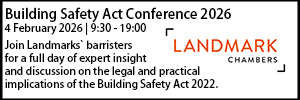County council loses High Court appeal over award of damages for boardwalk slip
- Details
Suffolk County Council has failed in a bid to overturn a damages award to a pedestrian who broke her ankle in an accident on a right of way boardwalk.
The High Court held the accident occurred on a surface Suffolk had opted to install - rather than on the ground - and so it was liable.
HH Moloney KC had awarded damages of £12,424.83 for the December 2020 accident to Samantha Lyall, but Suffolk appealed to the High Court on three grounds.
Mr Justice Jay said in his judgment these were that the judge failed properly to differentiate between public rights of way and highways maintainable at public expense, effectively held Suffolk to a significantly higher standard of care in negligence than imposed under statute, and failed properly to assess or consider the lack of foreseeability of such an accident.
Ms Lyall had been walking through Binney Woods, near Capel St Mary using a footpath which was a public right of way that Suffolk had a duty to maintain and repair.
The path is largely unmade-up but there are wooden bridges over ditches, and lengths of wooden boardwalk over boggy stretches. Ms Lyall slipped on one of the boardwalks and broke her left ankle.
HH Moloney had rejected arguments that Suffolk had a statutory duty to ensure the path was clear of vegetation, and also a common law negligence claim based on a failure to inspect.
But he upheld Ms Lyall’s argument on the need to consider specifying anti-slip measures.
Jay J said: “In my judgment, this is a straightforward case which raises no real issue of principle.”
He said that had Ms Lyall slipped on wet mud or grass on an unmade-up footpath she would have had no claim.
But she slipped on a stretch of wooden boardwalk that Suffolk had chosen to install and “that in my judgment makes all the difference, and transmutes the case into being one of a commission,” Jay J said.
“The foreseeable risk that arose thereby was one that [Suffolk] had both created and foresaw.”
He said HH Moloney’s analysis of whether Suffolk discharged its duty of care was correct and it should have considered the need to install anti-slip measures, but there was no evidence that any risk-assessment was carried out.
Dismissing the appeal, Jay J said:”The risk was greater in shady and damp areas of which the location of the accident was a clear example.
“Had there been evidence demonstrating that the defendant had addressed these factors yet nonetheless decided not to install any anti-slip measures, the claimant may have been in difficulty.”
Mark Smulian
Sponsored articles
Unlocking legal talent
Walker Morris supports Tower Hamlets Council in first known Remediation Contribution Order application issued by local authority
Contracts Lawyer
Lawyer (Planning and Regulatory)
Legal Director - Government and Public Sector
Locums
Poll









































